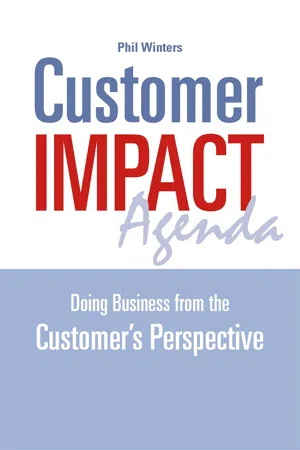Chapter 1: The Customer and ‘Customer Experience’
Before we can change our understanding of our customers, first we have to let go of some old ideas about markets and marketing; we then have to start thinking like our customers do. In traditional marketing terminology, the customer experience only begins once a consumer purchases and starts using a product or service, which leaves quite a lot of the customer’s actual experience with an organization off the table. However, meaningful consideration of the interactions that happen before the customer ever directly engages with you can have a far-reaching effect.
What taking the customer perspective can do for the organization
The common denominator among all the organizations I’ve worked with – indeed, probably of all organizations out there – is that they’re already customer focused. Without exception! They must be, in order to be able to sell a product or service, or focus an offering toward a group of individuals. This applies not only for business-to-consumer (BtoC) and business-to-business (BtoB) organizations, but to governments, charities and non-profit organizations, as well as religious institutions. Put simply: if they weren’t actually customer focused, they probably wouldn’t be in business (anymore).
However, another thing a majority of organizations also have in common is the misconception that just being customer focused means that they understand their customers.
Some of the errors commonly made include defining a ‘customer perspective’ as understanding the market. For any given organization, there’s no such thing as ‘the market’. There are groups of customers that have common needs, behaviors and values. Sometimes these will be very large groups that, once their potential is added together, reflect a substantial aggregate potential for an organization.
However, there are too many differences in most target customer audiences to simply boil everything down to a standardized ‘market’ definition; assuming so can be dangerous when putting a customer strategy in place. Instead, what’s required is fact-based insight that provides a foundation for defining target groups.
Another trap is the thought that “customer perspective” is somehow defined by the organization’s view of their customers. While this organizational perspective is indeed incredibly important because it allows us to structure manpower, processes, information-gathering and sharing, and IT systems around addressing and serving customers and prospects, it’s not a ‘customer perspective’.
Many customer relationship management (CRM) initiatives fall into this category; the more successful ones are probably those that have dealt with some aspect of focusing the view of the organization toward the customer.
Lastly, in my experience, there’s another thing common among all organizations: the need for a structured way of defining the customer, from the customer’s own perspective. That is what this book is about – providing a practical approach for organizations of any type to define both their customers and their interactions with those customers, starting with understanding the customer’s own perspective.
‘customer’ [1.02] A party that receives or consumes products (goods or services) and has the ability to choose between different products and suppliers
First, who or what is a customer?
Let’s first agree on what a customer is. The traditional definition of a customer is a person who buys or accepts products or services (see sidebar), but a more pertinent – even modern – concept comes from the “more generalized meaning a person with whom one has dealings [which] emerged [in the] 1540s [1.01].” Consumers, sports fans, doctors, merchandisers, community constituents and parishioners are therefore all examples of customers.
The key here is to consider anyone who’s the focus of an offer of a product, service or exchange as a customer. This person will have character traits, desires, wishes and needs, and will undertake activities that make him or her unique. This understanding of “customer” already goes far beyond the one underlying traditional direct marketing: customer = end consumer who buys.
But the generally accepted meaning of ‘customer’ does not stop with the individual. The customer has also been defined as a group of persons who have something in common, such as a household, a business, an agency, a governmental department or a group of businesses: in essence, a group that transacts as an entity for new products or services.
In this book, we’ll respond to the position held by many marketers that BtoB relationships are somehow far removed or vastly different from BtoC relationships. This couldn’t be further from the truth! At the end of the day, even in the BtoB world we’re still dealing with one or more individuals who make the buying decisions on behalf of their companies or groups.
‘customer experience’ [1.03] The entirety of the interactions a customer has with a company and its products. Understanding the customer experience is an integral part of customer relationship management. The overall experience reflects how the customer feels about the company and its offerings. Surveys, feedback forms and other data collection techniques help a company to determine the customer experience.
Expanding the definition of “customer experience”
The classic definition of customer experience is the sum of all experiences a customer has with a supplier of goods or services, over the duration of the relationship with that supplier. It can also be used to mean a single experience during one transaction; the distinction is usually clear in context.
Traditionally, the focus has been on the sequence of events that begins, usually post-purchase, once the customer actually starts using the product or service – and therefore starts interacting with the organization in a way that can be measured. Over time, many organizations have extended this to include the actual purchasing process.
In 2009, an initial attempt to define and measure customer experience within organizatio...
